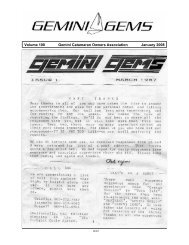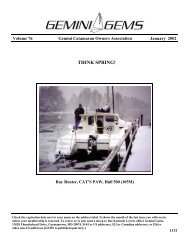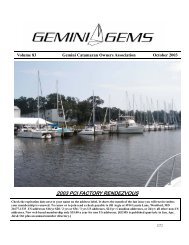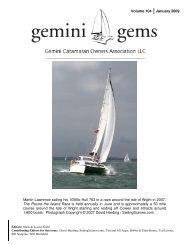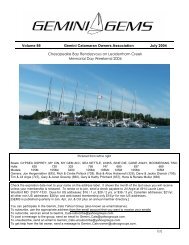Gemini Owners Manual.pub - Gemini Gems
Gemini Owners Manual.pub - Gemini Gems
Gemini Owners Manual.pub - Gemini Gems
Create successful ePaper yourself
Turn your PDF publications into a flip-book with our unique Google optimized e-Paper software.
<strong>Gemini</strong> 105Mc Owner’s <strong>Manual</strong><br />
FAQ Courtesy of BoatingMadeSimple.com<br />
Fading<br />
Antifouling paints are not meant to be cosmetic or decorative<br />
coatings and while every effort is made to make them<br />
as aesthetically pleasing as possible. The copper compound<br />
within the antifouling is difficult to mask with color pigments.<br />
All antifouling paints change when they are immersed. So<br />
don't be surprised when you have finished and the color is<br />
not what you had hoped from the color chart, The true color<br />
will establish itself after the boat has been launched. Copolymer<br />
and ablative type coatings tend to fade more than<br />
hard antifouling paints.<br />
Along the waterline you will often the antifouling looks dirty<br />
or faded, and can even turn green. This is due to the reaction<br />
of the paint with oxygen forming green copper oxide.<br />
Also paints with a higher copper content will turn greener at<br />
the waterline than paints with a lower copper content. For<br />
these reasons you should try keep the paint as close to the<br />
true waterline as possible. Fading is more noticeable in of<br />
ablative coatings than in hard coatings.<br />
How Often Should I Paint My Boat?<br />
That depends on the type of antifouling that is used. The<br />
longevity of multi-season copolymers such as Micron Extra &<br />
Micron CSC is related to the amount of paint applied. These<br />
paints will retain the antifouling properties as long as the<br />
paint is on the hull. Hard antifouling paints work by leaching<br />
biocide out of the paint film and leaving the paint film behind.<br />
When this paint film is left out of the water it oxidizes<br />
and any biocide that is left in the coating will not leach out<br />
at the proper rate to control fouling.<br />
Must I Sand the Bottom Before Repainting with the Same<br />
Antifouling Especially Since It Was Powerwashed in the<br />
Fall?<br />
Antifouling paint is not meant to be exposed to the elements<br />
and when it sits out of the water for a couple of months the<br />
outside layer of paint film becomes oxidized, and gets soft,<br />
plus it picks up dirt and dust. New paint does not adhere<br />
well to this type of surface and may begin to peel off. Most<br />
non-copolymer paints have a porous "leach layer" and if they<br />
are painted over, after just a power washing the pigment<br />
and the resin penetrate into that porosity and leave a<br />
"blush" of cuprous oxide on the surface. This is a cosmetic<br />
problem and does not really affect the antifouling quality of<br />
the paint but most people if they buy blue paint they want it<br />
to look blue not purple. High-pressure fresh water washing<br />
(3000 psi) will remove the leach layer but the paint will<br />
need to be over-coated immediately after it dries. The other<br />
reason for sanding antifouling paint is that there is only so<br />
much paint that will hold onto a given surface. That amount<br />
may be 10 coats or the first coat may delaminate. This is the<br />
related to how good the original surface preparation was<br />
and how it is maintained between recoating. Sanding when<br />
recoating will add to the longevity of the bottom jobs. By<br />
Bottom Paint FAQ<br />
sanding the bottom in the spring you will get more coats to<br />
adhere and forestall the day when you must remove all the<br />
antifouling paint from the surface. Soft rosin based antifoulings<br />
must always be sanded even if they have just been powerwashed.<br />
Keep in mind that the hulls require only a light handsanding<br />
and not a power sanding.<br />
What Is The Difference Between Hard & Soft Paints?<br />
Antifouling type is dictated by the quality, combination,<br />
quantity and type of resin.<br />
Copolymer and Ablative Antifoulings<br />
These types of antifoulings are partially soluble which means<br />
that as water passes across the surface of the coating, the<br />
coating wears down much like a bar of soap would wear<br />
away The action of the water steadily reduces the thickness<br />
of the paint at a controlled rate, which results in always<br />
having fresh biocide at the surface of the paint throughout<br />
the season. For this reason these types of antifoulings have<br />
the capability to perform in the areas of highest fouling<br />
challenge.<br />
Hard antifoulings leach the biocide out of the paint film and<br />
leave the paint film behind on the hull, which causes a build<br />
up of old, spent coatings, Because copolymer and ablative<br />
types of antifoulings wear away with use. There is no buildup<br />
of coatings that will eventually have to be removed from<br />
the surface. The minimal build up reduces the maintenance<br />
and preparation needed when it is time to apply more antifouling.<br />
In addition Copolymer types such as Micron Extra<br />
with Biolux and Micron CSC can be hauled and relaunched<br />
without repainting as the longevity these coatings are related<br />
to the thickness of the paint.<br />
Ablative types such as Fiberglass Bottomkote Act do not<br />
retain their antifouling ability for more than 30 days after<br />
being hauled out.<br />
Hard Antifoulings<br />
The technical term for these types of antifouling paints is<br />
"contact leaching". The paint dries to a porous film that is<br />
packed with Biocides, which leach out on contact with water<br />
to prevent fouling growth. This leaching is chemically design<br />
to release biocide throughout the season, but the amount<br />
will steadily decrease until there is not enough biocide coming<br />
out of the paint film to maintain fouling protection.<br />
Once the biocide is exhausted, the hard paint film remains<br />
on the boat. One of the main benefits of this type of antifouling<br />
is its resistance to abrasion and rubbing. This makes<br />
it ideal for fast powerboats, racing sailboats or boats where<br />
the owners have the bottoms cleaned regularly.<br />
Most hard antifouling paints can be wet sanded and burnished<br />
prior launch to reduce drag and improve hull speed.<br />
A disadvantage to hard antifouling paint is the buildup of<br />
residual paint film that occurs when the surface is not prop-<br />
Copyright © 2004 Performance Cruising Inc.<br />
60



